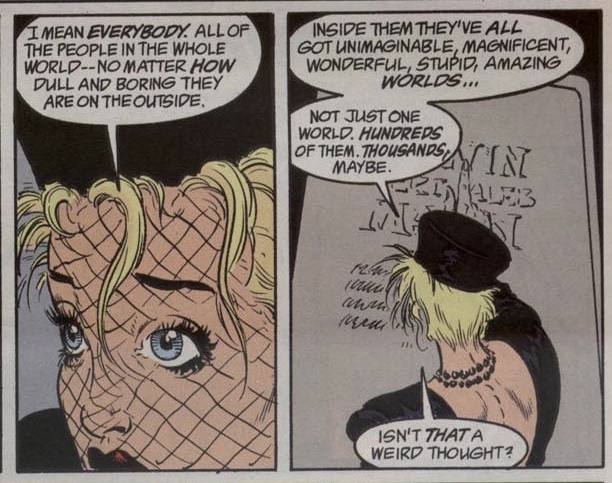
These comic panels are from the epilogue of Neil Gaiman’s “A Game of You,” the 5th book in his epic Sandman series. “A Game of You” follows the lead character Barbie’s journey through her own rich dream world, its entanglement with the dreams of others, and ultimately how that fantasy world collides with reality. It’s a brilliant story about stories, and their wonderful and terrifying power to shape who we are.
I decided to begin here firstly because, as I sat down to write on the subject of storytelling, I thought it important to affirm that each and every one of us is a storyteller. As Barbie muses, inside us we all have “unimaginable, magnificent, wonderful, stupid, amazing worlds.” Whether or not you realize or believe me when I say it, you tell stories constantly, and there is no one you create tales for more than yourself.
The human mind is not a hard drive. We do not store precise data with irrefutable evidence of the events in our lives. Memory is a mixture of facts we’re trying to retain and fictions we conjure up to fill in the gaps and form some semblance of a character arc for ourselves. Where have I been and where do I hope that I’m going? Stories keep us turning the pages. We have to internally narrate our own lives so we stay invested in the main character.
Which brings me to the second reason why I thought of Neil Gaiman and his dream-addled heroine, Barbie: He’s my favorite writer and she’s one of my favorite characters. In sharing this, my aim is for you to get to know me. Learning about another person is how we come to see them as a complete and significant character in their own right, and not just an extra in the background of our lives. Details that seem impertinent to the facts of a story are actually monumentally significant, because they make the events therein feel like they’re happening to a real person. And when a person is real, we care.
That is, in my assessment, the most vital ingredient of good storytelling: make me care.
Advertising is an exercise in economy of words. We have 30, 15, or even just 6 seconds to tell you a story. Within those parameters, the lion’s share of real estate must be given to essential fact dumping: this is our product; this is what it does; here is why you need it. Communicating those facts in a cohesive sequence is really not challenging. In fact, if that was all any ad had to achieve, brands would have no need for an agency like ours.
Thankfully for us, the relentlessly enduring obstacle of good storytelling is making people care. That’s why no matter what goods or services we may be selling, we always ask ourselves the questions that go beyond taglines and RTBs. “Who is our protagonist? Is it a character? Is it the viewer? What are they feeling? What do they worry about? Sure, they’re cleaning their clothes, but why do they need them so clean? Are they going somewhere? What kind of taco fillings are the best reflection of their personality?”
When editing down your story, especially for time, it will be tempting to bypass such questions, or allow their answers to be the first elements to hit the cutting room floor. My impassioned plea to you is to resist that urge. Your audience will likely never know that you have a full backstory for the mom brushing her daughter’s teeth in your commercial, but the absence of that story will leave a damaging mark. If you don’t take the time to make her real, your audience won’t care, and they won’t want to see what happens next.
An apt illustration of this human phenomena can be found in how we tell even our most mundane stories. What’s more compelling… telling a friend “I spilled coffee all over my shirt today” or prefacing that statement with “It’s my first day at the new job, I’ve already hit every single light since I left the house, and the only thing giving me a shred of confidence today is this ridiculous but awesome ‘Okay, but first coffee’ shirt…?”
We are storytelling animals. Suspense, style, and emotional context ignite our imaginations far more than cold hard facts. Clients will always want more, bigger, and longer shots of their product and their logo, but without making time for your audience to feel, those are just hollow, forgettable images. As a storyteller by profession, I believe it’s my job to make sure that time to feel is held sacred, from the first draft of a storyboard to the final cut. The good news in all of this which I devoutly believe, is that anyone can tell unforgettable stories, and you don’t need any special equipment or top secret skills to do so. You just need to invite others into your world, and to give them a reason to care.






